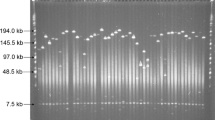Abstract
A bacterial artificial chromosome (BAC) library consisting of 235,000 clones with an average insert size of 130 kb was constructed from Capsicum annuum, 'CM334'. Based on a pepper haploid genome size of 2,702 Mbp/C, the BAC library is estimated to contain approximately 12 genome equivalents and represents at least 99% of the pepper genome. Screening of the library with mitochondrial DNA probes (coxII, coxIII, atp6 and atp9) and chloroplast DNA probes (atpB, rbcL) indicated that contamination with cytoplasmic DNA was less than 0.5%. To estimate the possibility of isolating a specific clone, the library was screened with single or low-copy gene-specific probes and RFLP probes. Screening of high density BAC filters with RFLP markers linked to L (TMV resistance), y (fruit color), C2 (fruit color) and C (pungency) loci under high stringency conditions revealed that at least three positive BAC clones were found per each probe. This fact indicates that the library is highly reliable and represents a resource for map-based cloning, physical mapping, and characterization of upstream and downstream regulations of the chili pepper genes.


Similar content being viewed by others
References
Arumuganthan K, Earle ED (1991) Nuclear DNA content of some important plant species. Plant Mol Biol Rep 9:208–219
Ben Chaim A, Grube RC, Lapidot M, Jahn M, Paran I (2001) Identification of quantitative trait loci associated with tolerance to cucumber mosaic virus in Capsicum annuum. Theor Appl Genet 102:1213–1220
Blum E, Liu K, Mazourek M, Yoo EY, Jahn M, Paran I (2002) Molecular mapping of the C locus for presence of pungency in Capsicum fruit. Genome 45:702–705
Caranta C, Thabuis A, Palloix A (1999) Development of a CAPS marker for the Pvr4 locus: a tool for pyramiding potyvirus resistance genes in pepper. Genome 42:1111–1116
Grube RC, Blauth JR, Arnedo M, Caranta C, Jahn M (2000a) Identification and comparative mapping of a dominant potyvirus resistance gene cluster in Capsicum. Theor Appl Genet 101:852–859
Grube RC, Radwanski ER, Jahn M (2000b) Comparative genetics of disease resistance within the Solanaceae. Genetics 155:873–887
Huh JH, Kang BC, Nahm SH, Kim S, Ha KS, Lee MH, Kim BD (2001) Candidate gene approach identified phytoene synthase as the locus for mature fruit color in red pepper (Capsicum spp.). Theor Appl Genet 102:524–530
Kang BC, Nahm SH, Huh JH, Yoo HS, Lee MH, Kim BD (2001) Combined molecular linkage map construction using RFLP and AFLP in hot pepper. Theor Appl Genet 102:531–539
Kim M, Kim S, Kim BD (2001) Isolation of cDNA clones differentially accumulated in the placenta of pungent pepper by suppression subtractive hybridization. Mol Cells 11:213–219
Lefebvre V, Palloix A (1996) Both epistatic and additive effects of QTLs are involved in polygenic induced resistance to disease; a case study, the interaction pepper-Phytophthora capsici Lenonian. Theor Appl Genet 93:503–511
Lefebvre V, Palloix A, Caranta C, Pochard E (1995) Construction of an intraspecific integrated linkage map of pepper using molecular markers and doubled-haploid progenies. Genome 38:112–121
Lefebvre V, Kuntz M, Camara B, Palloix A (1998) The capsanthin-capsorubin synthase gene: a candidate gene for the y locus controlling the red fruit colour in pepper. Plant Mol Biol 36:785–589
Livingstone KD, Lackney VK, Blauth JR, van Wijk R, Jahn MK (1999) Genome mapping in capsicum and the evolution of genome structure in the Solanaceae. Genetics 152:1183–1202
Tai TH, Dahlbeck D, Clark ET, Gajiwala P, Pasion R, Whalen MC, Stall RE, Staskawicz BJ (1999) Expression of the Bs2 pepper gene confers resistance to bacterial spot disease in tomato. Proc Natl Acad Sci USA 96:14,153–14,158
Woo SS, Jiang J, Gill BS, Paterson AH, Wing RA (1994) Construction and characterization of a bacterial artificial chromosome library of Sorghum bicolor. Nucleic Acids Res 22:4922–4931
Yoo EY, Kim S, Kim JY, Kim BD (2001) Construction and characterization of a bacterial artificial chromosome library from chili pepper. Mol Cells 12:117–120
Zhang HB, Zhao XP, Ding XD, Paterson AH, Wing RA (1995) Preparation of megabase-sized DNA from plant nuclei. Plant J 7:175–184
Acknowledgements
This work was supported in part by a grant from Korea Science and Engineering Foundation (KOSEF) to the Center for Plant Molecular Genetics and Breeding Research (CPMGBR). The authors thank Molly Jahn and Steve Tanksley for generously providing the E35/M48-101 AFLP marker and the TG205 RFLP marker. We also thank Doil Choi for providing the CDI136 marker and Kyungsuk So for technical assistance.
Author information
Authors and Affiliations
Corresponding author
Additional information
Communicated by J. Dvorak
Rights and permissions
About this article
Cite this article
Yoo, E.Y., Kim, S., Kim, Y.H. et al. Construction of a deep coverage BAC library from Capsicum annuum, 'CM334'. Theor Appl Genet 107, 540–543 (2003). https://doi.org/10.1007/s00122-003-1279-z
Received:
Accepted:
Published:
Issue Date:
DOI: https://doi.org/10.1007/s00122-003-1279-z




